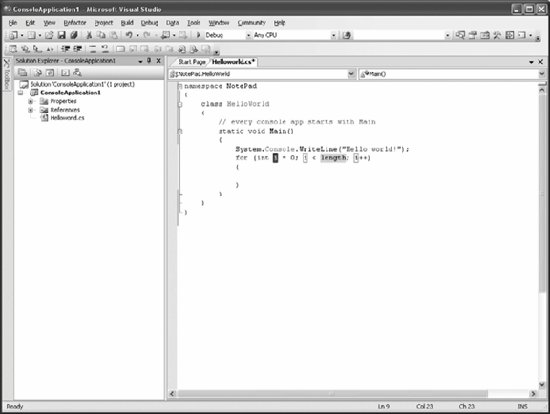A.3. Chapter 3: C# Language Fundamentals A.3.1. Quiz -
Solution to Question 31 .
-
True or False. -
Solution to Question 32 .
-
int is the C# alias for the .NET Int32 type. They can be used interchangeably. -
Solution to Question 33 .
-
All except the last, which requires an explicit cast: int newInt = (int) myLong;
-
Solution to Question 34 .
-
A uint is an unsigned int and can hold only positive numbers , but it can hold a positive value twice as big as an int (4 million+ rather than 2 million+). -
Solution to Question 35 .
-
A float takes four bytes and a double takes eight bytes, and thus a double can represent much larger values with greater precision. Figure A-3. Exercise 2-3  -
Solution to Question 36 .
-
In C, if you wish to use a variable of any type (pass it as a parameter to a method), you must assign it a value. -
Solution to Question 37 .
-
You refer to the constant like this: Temperatures.LightJacketWeather
Its value is 33. -
Solution to Question 38 .
-
Any statement that evaluates to a value. A.3.2. Exercises -
Solution to Exercise 3-1 .
-
Write a short program creating and initializing each of the following types of variables : int , float , double , char , and then outputting the values to the console. namespace fundamentals { class exercise { static void Main( ) { int myInt = 3; float myFloat = 4.25f; double myDouble = 123456789.9867; char myChar = 'A'; System.Console.WriteLine("myInt: {0}, myFloat: {1}, myDouble: {2}, myChar: {3}.", myInt, myFloat, myDouble, myChar); } } }
The output should look like this: myInt: 3, myFloat: 4.25, myDouble: 123456789.9876, myChar: A.
-
Solution to Exercise 3-2 .
-
Modify the program in Exercise 3-1 to change the values of variables and output the values to the console a second time: namespace fundamentals { class exercise { static void Main( ) { // round one int myInt = 3; float myFloat = 4.25f; double myDouble = 123456789.9867; char myChar = 'A'; System.Console.WriteLine("Round 1: myInt: {0}, myFloat: {1}, myDouble: {2}, myChar: {3}.", myInt, myFloat, myDouble, myChar); // round two myInt = 5; float myFloat = 25.267f; myDouble = 987654321.1234; myChar = 'Z'; System.Console.WriteLine("Round 2: myInt: {0}, myFloat: {1}, myDouble: {2}, myChar: {3}.", myInt, myFloat, myDouble, myChar); } } }
The output should look like this: Round 1: myInt: 3, myFloat: 4.25, myDouble: 123456789.9876, myChar: A. Round 2: myInt: 5, myFloat: 25.267, myDouble: 987654321.1234, myChar: Z.
-
Solution to Exercise 3-3 .
-
Modify the program in Exercise 3-2 to declare a constant float Pi equal to 3.14159. Then assign a new value to pi (3.1) and output its value with the other variables statement. What happens when you try to compile this program? namespace fundamentals { class exercise { static void Main() { const float pi = 3.14159f; int myInt = 3; float myFloat = 4.25f; double myDouble = 123456789.9867; char myChar = 'A'; pi = 3.1f; System.Console.WriteLine("Round 1: myInt: {0}, myFloat: {1}, myDouble: {2}, myChar: {3}. Pi: {4}", myInt, myFloat, myDouble, myChar, pi); } } }
This program won't compile, because you're trying to assign a value to a constant. Instead, you receive a compiler error that reads, "The left-hand side of an assignment must be a variable, property or indexer." |
